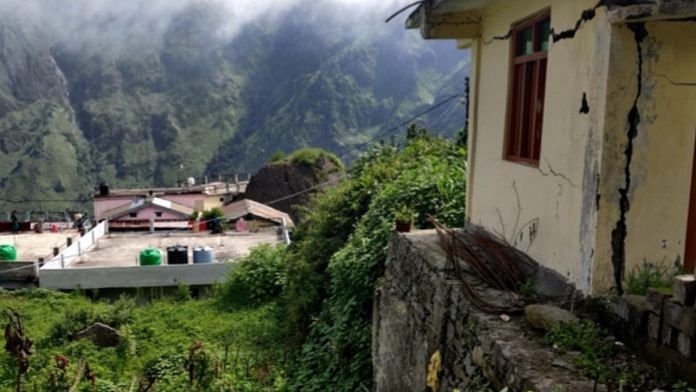The catastrophe in Uttarakhand’s Joshimath is one in the long list of environmental disasters, often exacerbated by human negligence, to strike India. Some of the economic losses could have been avoided had we followed warnings from environmental risk assessments and better construction standards. Losses are, however, inevitable when disaster strikes. How best to allocate these losses should become a core concern of public policy, given India’s exposure to climate change. Our toolkit for dealing with disasters needs to be fortified through catastrophe insurance.
Why catastrophe insurance?
India is vulnerable to natural disasters, with almost 75 per cent districts classified as extreme event hotspots. It is not feasible to provide financial support in the aftermath of a disaster only through fiscal tools. Fiscal transfers to households may not be enough to repair and rebuild properties and livelihoods.
It is useful to quantify ‘contingent liability’ on the government from disasters. That is, assuming the current trend of earthquakes, cyclones, and floods continues, what is the expected financial outflow of governments? Can a part of this liability be transferred to private insurance markets? The core business of insurance is to manage risk. Consider an insurance company that has sold earthquake insurance in all parts of India. When an earthquake strikes one location, it has to make payouts only in that location. It is, therefore, diversified.
However, the insurance company does have to make a payout to all policyholders in the earthquake-affected region. In that sense, it still is not able to diversify risks the way it is able to do in, say, life insurance or auto insurance products. The insurance company charges households a premium based on the annual expected loss—that is, the payout it expects to make given the probability of the event and the severity of the loss it can cause—and the administrative cost of providing the cover. The company, in turn, buys insurance from international reinsurance companies. This is important because a natural disaster with high losses has the potential to bankrupt a single firm.
Also read: Bank harassment, hidden charges undoing gains of Modi’s PMJDY and financial inclusion
The catastrophe insurance market in India
There is no specific earthquake (or natural disaster) policy sold in India. It is generally part of a standard fire insurance policy that covers damage to the property from events such as flooding, cyclone, fire etc. Earthquake protection can be purchased as an add-on. Households often do not know of these products or have a low assessment of the extent of their exposure. It could also be that trust in insurance firms is low, and one is never really sure of the extent of coverage one is signing up for.
Insurance companies, in turn, may not want to push for the sale of these policies because they risk losing significant capital if a catastrophic event occurs and claims have to be paid. Good pricing requires high-quality data that allows for modelling the probability of an adverse event as well as estimating potential losses. Such datasets are likely to not be available for India, making pricing difficult for the domestic and international reinsurance market. Uncertainty causes insurers to set aside excess loss reserves, leading to an increase in premiums.
Also read:
Government-facilitated insurance
These problems are not unique to India. In 1995, the US state of California faced a similar issue, whereby 93 per cent of the local homeowners insurance market had either restricted or stopped writing homeowners policies altogether. The California legislature then created a no-frills policy that a private insurer could sell. In 1996, it also set up a not-for-profit, publicly managed and privately funded entity, the California Earthquake Authority (CEA), which offers earthquake insurance policies through certain insurance providers. Similarly, in 2000, the Turkish government started the Turkish Catastrophe Insurance Pool (TCIP), which provides earthquake insurance up to a specific ceiling. TCIP is managed as a private insurance company under the guidance of the Turkish treasury.
A wide range of public-private partnerships, which offer some element of catastrophe insurance, have emerged worldwide. In some countries, the government has assumed the role of a ‘direct insurer’ by setting up funds, such as the Earthquake Commission in New Zealand. In other markets, governments play the role of ‘reinsurer’— such as the Australian Reinsurance Pool Corporation in Australia and the National Catastrophe Insurance Fund in Thailand. The type of insurance offered also varies, from residential property damage to commercial property damage and business interruption. There are also different models to ensure that the funding and governance of these entities do not impose new burdens on the government budget either through poor pricing or mismanagement of funds.
Developments in India include a Memorandum of Understanding (MoU) between the Nagaland State Disaster Management Authority, Tata AIG General Insurance Company Limited, and Swiss Re (as a reinsurance partner). The goal is to provide coverage for excess rainfall events that can cause severe flooding in the Northeastern state. The National Disaster Management Authority (NDMA) also seems to be considering an index-insurance type solution for the livelihood protection of low-income households in the event of a natural calamity. The outcomes of these critical initiatives may well shape the future of catastrophe insurance in India.
State governments should consider the possibility of setting up a public-private partnership and harnessing the power of financial markets. There are crucial decisions to be taken on the design of the product, pricing, and investment management. As each state evaluates the model suited to its need, it should crowd in the private insurance industry and ensure financial sustainability.
Renuka Sane is research director at Trustbridge, which works on improving the rule of law for better economic outcomes for India. Views are personal.
(Edited by Zoya Bhatti)



